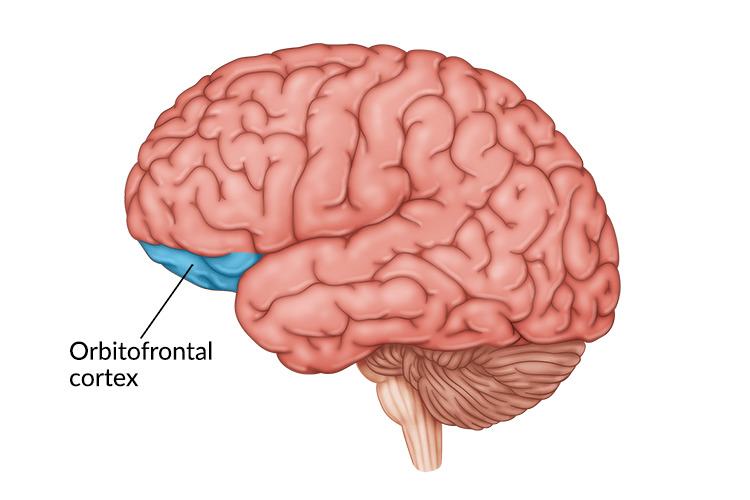Orbitofrontal Cortex (OFC) is a region of the prefrontal cortex located in the frontal lobes of the brain, situated just above the orbits of the eyes. The OFC is critically involved in decision-making, value representation, emotional regulation, and adaptive social behavior. Technically, it integrates sensory, emotional, and reward-related information to guide flexible behavior. In accessible terms, the OFC helps individuals evaluate options, predict outcomes, and adjust behaviors based on changing environments.
Orbitofrontal Cortex (OFC)
| |
|---|---|
| Full Name | Orbitofrontal Cortex (OFC) |
| Core Characteristics | Prefrontal region involved in reward evaluation, emotional regulation, decision-making, and adaptive social behavior |
| Developmental Origin | Derived from the telencephalon during fetal brain development; matures into early adulthood |
| Primary Functions | Reward valuation, outcome prediction, impulse control, sensory integration, emotional judgment |
| Role in Behavior | Guides flexible decision-making based on expected rewards and punishments; critical for social appropriateness |
| Associated Traits | Emotional regulation, behavioral inhibition, goal-directed behavior, moral reasoning |
| Contrasts With | Dorsolateral prefrontal cortex (DLPFC) (more focused on abstract reasoning and working memory) |
| Associated Disciplines | Neuroscience, neuropsychology, psychiatry, cognitive science |
| Clinical Relevance | Dysfunction implicated in impulsivity, addiction, obsessive-compulsive disorder, antisocial behaviors, and mood disorders |
| Sources: Rolls (2000), Bechara et al. (2000), Kringelbach (2005) | |
Other Names
Ventral prefrontal cortex, prefrontal orbital region
History
The orbitofrontal cortex was first anatomically described in the 19th century by early neuroanatomists such as Paul Broca. Its role in behavior was notably inferred following the famous case of Phineas Gage in 1848, whose profound personality changes after a prefrontal injury highlighted the importance of frontal brain regions.
Experimental lesion studies in primates during the 20th century clarified the OFC’s role in reward learning and behavioral flexibility. Modern neuroimaging and electrophysiological techniques have expanded understanding of its integrative function across emotion, cognition, and adaptive decision-making.
Anatomy
Gross Anatomy
The orbitofrontal cortex is located on the ventral surface of the frontal lobe, directly above the orbital cavities. It is part of Brodmann areas 10, 11, 12, and 47.
It receives inputs from multiple sensory modalities (olfactory, gustatory, visual, somatosensory) and projects to limbic, striatal, and other prefrontal regions.
Cytoarchitecture
The OFC is characterized by agranular to dysgranular cortical organization:
- Medial OFC areas are typically agranular (lacking distinct layer IV)
- Lateral OFC areas are more dysgranular (incomplete or patchy layer IV)
This structural variation corresponds to functional differences in emotional versus cognitive processing within subregions of the OFC.
Subdivision
The OFC is subdivided into medial, central, and lateral networks:
- Medial OFC: Emotion, reward value, subjective pleasure
- Lateral OFC: Response inhibition, outcome revaluation
- Anterior OFC: Social cognition, abstract reward prediction
Development
The orbitofrontal cortex undergoes prolonged postnatal development, continuing into the third decade of life. It is among the last brain regions to fully myelinate.
During adolescence, synaptic pruning and strengthening shape the OFC’s capacity for flexible decision-making, impulse control, and complex social evaluations.
Dysregulated OFC development has been implicated in mood disorders, impulsivity, and social behavioral abnormalities.
Cell Types
- Pyramidal neurons: Excitatory projection neurons forming extensive intracortical and subcortical connections.
- GABAergic interneurons: Including parvalbumin-positive and somatostatin-positive cells, crucial for inhibitory regulation and synchronization.
- Glial cells: Astrocytes and oligodendrocytes supporting metabolic demands and signal transmission.
Neuronal diversity underpins the OFC’s ability to process multimodal inputs and maintain flexible behavioral outputs.
Signaling Pathways
Neurotransmitters
- Glutamate: Primary excitatory transmission supporting cognitive processing.
- GABA: Inhibitory transmission regulating circuit stability and precision.
- Dopamine: Modulates reward sensitivity, salience attribution, and goal-directed behavior.
- Serotonin: Involved in mood regulation and impulse control within the OFC.
Connectivity
- Afferent connections: Amygdala (emotion), thalamus (sensory relay), hippocampus (memory context)
- Efferent projections: Nucleus accumbens (reward system), hypothalamus (autonomic regulation), dorsolateral prefrontal cortex (executive control)
Function in Psychology
The orbitofrontal cortex contributes to:
- Decision-making under uncertainty: Weighing risk versus reward in dynamic environments.
- Social cognition: Interpreting social norms, emotional facial expressions, and moral reasoning.
- Emotional regulation: Suppressing inappropriate emotional responses and calibrating affective reactions based on context.
- Value updating: Modifying behavioral strategies based on shifting reward contingencies.
Damage or dysfunction of the OFC impairs the ability to adjust behaviors flexibly, leading to perseveration, impulsivity, and poor emotional regulation.
Pathology
Lesions or degeneration affecting the OFC are associated with:
- Frontal lobe syndromes: Disinhibition, poor judgment, emotional blunting
- Traumatic brain injury: Especially orbital blows or coup-contrecoup injuries
- Neurodegenerative diseases: Frontotemporal dementia prominently affects OFC-mediated behaviors
Pathophysiology
Orbitofrontal dysfunction contributes to multiple psychiatric disorders:
- Obsessive-Compulsive Disorder (OCD): Hyperactivation of OFC-striatal circuits correlates with compulsive ritual behaviors.
- Major Depressive Disorder (MDD): Altered OFC connectivity affects valuation of rewards and affect regulation.
- Addiction: Impaired outcome evaluation and loss of behavioral flexibility contribute to compulsive drug-seeking behaviors.
- Social anxiety disorder and PTSD: Aberrant OFC-amygdala communication impacts threat appraisal and emotional memory integration.
Functional neuroimaging consistently implicates OFC hypoactivity or hyperactivity patterns across these disorders depending on symptomatology.
In the News
- Advances in DBS (Deep Brain Stimulation): Targeting OFC circuits shows promise for treatment-resistant depression and OCD.
- Neuroeconomic research: Studies explore how OFC activity predicts consumer choice and decision biases.
- Trauma and frontal vulnerability: Discussions emphasize OFC fragility in blast injuries and concussions among military personnel and athletes.
Media
Books
The Orbitofrontal Cortex by Edmund Rolls explores computational models of OFC function.
Films and Television
Neuropsychological documentaries, such as PBS’s The Brain with David Eagleman, feature explorations of frontal lobe functions including the OFC.
Poetry and Art
Artistic metaphors about choice, morality, and emotional risk often allegorically reflect OFC-mediated internal experiences.
Publications
Research on the orbitofrontal cortex spans systems neuroscience, clinical psychiatry, decision neuroscience, computational modeling, and affective neuroscience. Topics include reward-based learning, emotional regulation circuitry, social decision-making, and therapeutic interventions targeting OFC dysfunction.
- Surface-based functional brain imaging analysis of major depressive disorder after electroconvulsive therapy
- Dissociating Frontal Lobe Lesion Induced Deficits in Rule Value Learning Using Reinforcement Learning Models and a WCST Analog
- Decoding the Altruistic Brain: An ALE Meta-Analysis of the Functional Localization of Giving Behaviors
FAQs
What happens if the orbitofrontal cortex is damaged?
Damage can result in disinhibition, impulsivity, emotional flatness, poor social judgment, and inflexible behavior patterns.
Is the OFC involved in emotions or thinking?
Both. It integrates emotional significance with cognitive evaluation to guide behavior flexibly in changing contexts.
How does the OFC relate to reward processing?
The OFC evaluates the subjective value of rewards and updates predictions when outcomes differ from expectations.
Is the orbitofrontal cortex plastic?
Yes. The OFC remains plastic throughout life, adapting to experience, environmental change, and therapeutic interventions.




